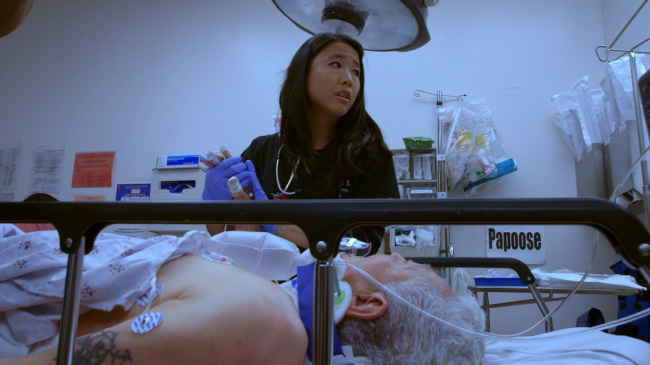‘Code Black’ captures ER at best, health system at most bureaucratic
By Korea HeraldPublished : Aug. 1, 2014 - 21:02
“Code Black” opens in chaos, settles into systemic calm and ends with young doctors struggling against “the failure of the system” to get back some of that chaos.
But this isn’t this year’s new variation on TV’s “young doctors, under stress and in love.” It’s a documentary film filled with adrenalin junkies, idealistic Type-A personalities and over-achievers. They’re residents at L.A. County Hospital’s “legendary” emergency room, capturing the urgency and immediacy of this last line of defense against sudden death.
Ryan McGarry, who directed this, was one of them while making this film, a doctor put through the wringer of working in the emergency room that basically invented the concept of “emergency room.” His over-ambitious, short and sweet film wanders over much of the malfunctioning medical landscape in message. Heroic doctors (nurses are somewhat shortchanged), dedicated healers all, stay calm, cool and collected as they deal with gunshot wounds, heart attacks and every emergency malady known to humanity.
If only there wasn’t all this paperwork. If only Congress hadn’t created a medical system that allowed for-profit hospitals to dump “a tidal wave” of patients with no insurance packing off to public hospitals. If only doctors could get back to what they got into medicine for ― meeting patients, finding out what ails them and helping them.
But this isn’t this year’s new variation on TV’s “young doctors, under stress and in love.” It’s a documentary film filled with adrenalin junkies, idealistic Type-A personalities and over-achievers. They’re residents at L.A. County Hospital’s “legendary” emergency room, capturing the urgency and immediacy of this last line of defense against sudden death.
Ryan McGarry, who directed this, was one of them while making this film, a doctor put through the wringer of working in the emergency room that basically invented the concept of “emergency room.” His over-ambitious, short and sweet film wanders over much of the malfunctioning medical landscape in message. Heroic doctors (nurses are somewhat shortchanged), dedicated healers all, stay calm, cool and collected as they deal with gunshot wounds, heart attacks and every emergency malady known to humanity.
If only there wasn’t all this paperwork. If only Congress hadn’t created a medical system that allowed for-profit hospitals to dump “a tidal wave” of patients with no insurance packing off to public hospitals. If only doctors could get back to what they got into medicine for ― meeting patients, finding out what ails them and helping them.

McGarry’s film opens in a maelstrom of blood, pain and medicine, as practiced under institutional lighting. The ancient “C-Booth,” a 20-by-25 room where ER practices were born, is so crowded that you wonder how anyone could possibly be saved in all this disorder. I counted 12-13 people in camera operators McGarry, Sandra Chandler and Nelson Hume’s tightly framed shots ― “the team,” doctors and nurses and the EMTs who got this patient there, family, a tiny balcony where med students observe this whirl of activity.
Off to one side, calmest of the calm, is “the chairman,” the attending resident ― directing traffic, moving team members, instructing each other, encouraging each other. Get that tray over here, get that tube inserted.
“All the way in. All the way in. All the way in.”
But at the center of it all is the patient, the focus of every single person’s attention. Gurneys crowd against each other and frankly, it looks a bit Third World. Still, the teamwork, the dedication and the urgency of this “blue collar” corner of medicine is stunning ― more impressive than any mere TV episode recreating the chaos.
That was the way it was before L.A. County got a new ER One of the central debates at the heart of McGarry’s film is what was lost when the hospital had to come in compliance with the myriad of regulations that protect it, the doctors and nurses who work there and the government which funds it from invasions of privacy, mistakes and the lawsuits that follow.
McGarry and his teammates lament the “profit and efficiency” that are paramount in our cost-obsessed culture. They scramble to try new ways to re-invigorate an overwhelmed system ― a 300-person waiting room can lead to 18-hour waits at L.A. County.
Though the film doesn’t get into the relative inexperience of those younger staff ― a common complaint about emergency medicine ― McGarry does a nice job of at least listing the many barriers to providing great care and the need for health care reform that goes beyond merely making sure everyone is insured.
The more experienced doctors show up to toss a bucket of water on their idealism. Costs, nurse burnout and malpractice claims are real world problems, and “the system,” cumbersome as it is, is aimed at minimizing those, something the newbies are slow to pick up on.
A favorite moment: An elderly woman explains to young Dr. McGarry the self-medicating she’s been doing for her sciatica. The kid doesn’t know what “Mary Jane” is.
The older doctors and nurses don’t romanticize “the day of the cowboy,” the chaotic past of an ER run by the seat-of-the-pants.
But McGarry, with this slick, invigorating film, whose action is set to a pulsating James Lavino musical score, has broadened a national debate that anti-healthcare reform folks have narrowed via the courts and political demonization.
By Roger Moore
(McClatchy-Tribune News Service)
(MCT Information Services)
-
Articles by Korea Herald


![[AtoZ into Korean mind] Humor in Korea: Navigating the line between what's funny and not](http://res.heraldm.com/phpwas/restmb_idxmake.php?idx=644&simg=/content/image/2024/04/22/20240422050642_0.jpg&u=)


![[Herald Interview] Why Toss invited hackers to penetrate its system](http://res.heraldm.com/phpwas/restmb_idxmake.php?idx=644&simg=/content/image/2024/04/22/20240422050569_0.jpg&u=20240422150649)
![[Exclusive] Korean military set to ban iPhones over 'security' concerns](http://res.heraldm.com/phpwas/restmb_idxmake.php?idx=644&simg=/content/image/2024/04/23/20240423050599_0.jpg&u=20240423183955)
![[Graphic News] 77% of young Koreans still financially dependent](http://res.heraldm.com/phpwas/restmb_idxmake.php?idx=644&simg=/content/image/2024/04/22/20240422050762_0.gif&u=)







![[Exclusive] Korean military to ban iPhones over security issues](http://res.heraldm.com/phpwas/restmb_idxmake.php?idx=652&simg=/content/image/2024/04/23/20240423050599_0.jpg&u=20240423183955)



![[Today’s K-pop] Ateez confirms US tour details](http://res.heraldm.com/phpwas/restmb_idxmake.php?idx=642&simg=/content/image/2024/04/23/20240423050700_0.jpg&u=)